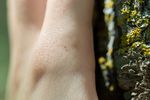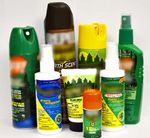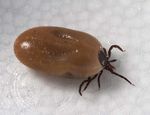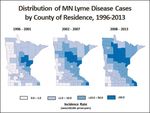Ticks & Tickborne Diseases of Minnesota - Vectorborne Diseases Unit Last Updated July 18, 2018 - Minnesota Department of ...
←
→
Page content transcription
If your browser does not render page correctly, please read the page content below
What is a tickborne disease and why should you care about it? • People can get a tickborne disease when they are bitten by a tick that is infected with a disease agent • The number of people getting tickborne diseases is increasing throughout the United States, including Minnesota • Personal protection methods can help keep you safe from tick bites and tickborne diseases while enjoying healthy outdoor activities
Goals of Presentation • Be able to recognize ticks of public health concern in MN • Be aware of tickborne diseases • Recognize basic signs and symptoms • Seek early diagnosis and treatment • Know when and where tickborne disease risk is highest • Practice prevention methods • Know who to contact for more information
3 Main Ticks of Public Health Concern in Minnesota
Blacklegged (Deer) Tick American Dog (Wood) Tick Lone Star Tick
Lyme disease Rocky Mountain Spotted Fever Ehrlichiosis
Anaplasmosis Tularemia Tularemia
Babesiosis Heartland virus disease
Ehrlichiosis Southern Tick-Associated Rash Illness
Powassan virus disease (STARI)Questing What blacklegged ticks do: • Search for a host from the tips of low-growing vegetation • Sense body chemicals and other cues from potential hosts • Climb onto a person or animal near ground level as they walk by What blacklegged ticks don’t do: • Jump • Fly • Fall from treetops • See
Tickborne Disease Risk in Minnesota Photo courtesy of MN Department of Natural Resources (accessed 2/16/2018) http://www.dnr.state.mn.us/biomes/index.html
Reported Tickborne Disease Cases in Minnesota, 1996-2017
1600
1400
1200
Number of Cases
1000
800
600
400
200
0
1996 1997 1998 1999 2000 2001 2002 2003 2004 2005 2006 2007 2008 2009 2010 2011 2012 2013 2014 2015 2016 2017
Year of Diagnosis
Lyme disease Anaplasmosis BabesiosisWhat are the symptoms of a tickborne disease? • Many tickborne diseases have similar symptoms • Initial symptoms usually show up within 2-4 weeks of being bitten by an infected tick • Watch for symptoms like: • Rash • Fever • Headache • Fatigue • Muscle or joint aches
How are tickborne diseases diagnosed? • If you think that you may have a tickborne disease, contact your health care provider as soon as possible • Your health care provider can determine if you have a tickborne disease based on your: • History of being around wooded or brushy areas (where ticks may live) • Physical examination • Laboratory tests
Are tickborne diseases treatable? • Most tickborne diseases are treatable • For most people, the prognosis is good and symptoms go away after treatment • Talk with your health care provider about managing symptoms that have not resolved after treatment
Lyme Disease
• Borrelia burgdorferi
• Symptoms
• Characteristic Rash (erythema migrans)
• Fever
• Muscle or joint pain
• Fatigue
• Diagnosis
• History of exposure to ticks or wooded areas
• Physical examination
• Laboratory testing
• Treatment
• AntibioticsAnaplasmosis
• Anaplasma phagocytophilum
• Symptoms
• Fever
• Severe headache
• Muscle or joint pain
• Severe complications and death possible
• Diagnosis
• History of exposure to ticks or wooded areas
• Physical examination
• Laboratory testing
• Treatment
• AntibioticsBabesiosis
• Babesia microti
• Symptoms
• Fever
• Headache
• Fatigue
• Severe complications and death possible
• Diagnosis
• History of exposure to ticks or wooded areas
• Physical examination
• Laboratory testing
• Treatment
• Patients without symptoms may not require treatment
• Combination of anti-protozoal and antibioticRare/Emerging Tickborne Disease Agents in Minnesota
Powassan virus
Ehrlichia muris eauclairensis
Borrelia mayonii
Borrelia miyamotoi
Rickettsia rickettsii*
Francisella tularensis*
*transmitted by the American dog (wood) tick, not the blacklegged tickProtect Yourself from Tickborne Diseases
1) Know when and where you’re at risk
• Primarily Mid-May through mid-July
• Wooded and brushy areas – Blacklegged tick
• Grassy or wooded areas – American dog tick
2) Wear EPA-registered tick repellent
• DEET 20-30% on skin or clothing
• Permethrin 0.5% on clothing
3) Check yourself for ticks
• Undress and shower after being outdoors
• Check at least once a day https://youtu.be/djOa3UdGuMs
• Remove ticks ASAP!Tick Removal https://www.youtube.com/watch?v=yLUkAlLsOVc&feature=player_embedded
Other Tick Prevention Methods
Tumble dry clothing on high for ≥ 6 (dry) - 60 (wet) minutes
Keep lawn and trails mowed short
Remove leaf litter and brush
Create a barrier between your yard and woods
Talk with your vet about tick preventatives for your pets
Image courtesy of Kirby Stafford,
Connecticut Agricultural Experiment Station, New HavenBe Aware of Tickborne Disease Symptoms
Contact your doctor if you notice:
Rash
Fever
Headache
Fatigue
Muscle or joint achesThank You!
Questions?
Minnesota Department of Health
Vectorborne Diseases Unit
651-201-5414
health.bugbites@state.mn.usYou can also read



























































